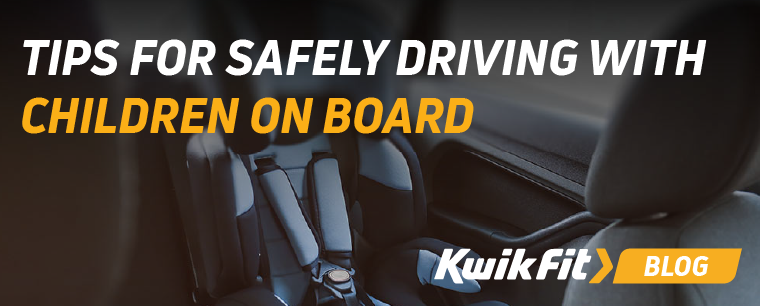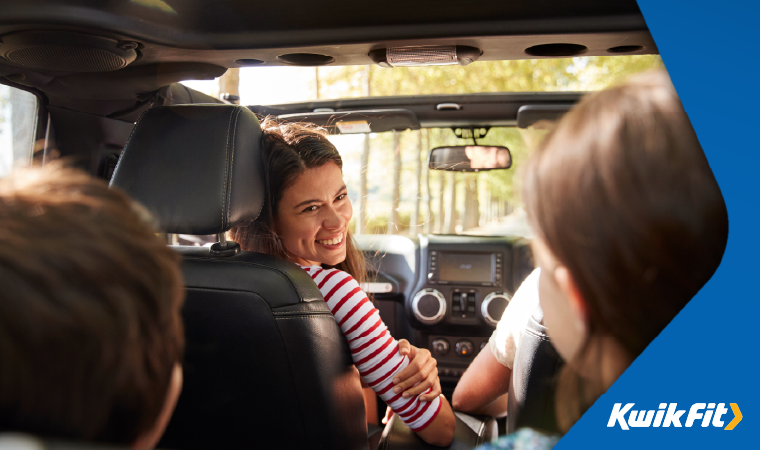Tips For Safely Driving With Children Onboard
Jessica Bird | Sunday 25th May 2025 11:20am

Anyone who has ever had to do so will agree that looking after children in any capacity is a ton of responsibility – but driving with children in the car adds a whole new layer of worry. Whether you’re on a school run, heading out for a weekend away, or just popping to the shops, your focus is always split between the road and that precious cargo in the back seat(s).
It can be a lot to keep your mind on, so here are some practical tips for keeping your children safe and secure every time you hit the road.
Use the right car seat - and use it properly
Especially with younger kids, your most important line of defence is a well-fitted, age-appropriate child car seat. Vehicle seats and seatbelts are designed to hold adults in the event of a collision, which means that they’re not properly aligned to protect children should the worst happen.
As such, UK law requires children to use a child seat until they are 12 years old or 135cm tall, whichever comes first. There are two main types of legal child car seats: Regulation 129 and Regulation 44.
- Regulation 44: also known as R44 child seats. These are chosen based on the weight of your child and can be fitted either to ISOFIX anchor points (if your car has them) or to your car’s seatbelt. Models vary, but ISOFIX is a much safer bet (more on this later). While these types of car seat are still legal, they’re being phased out in favour of R129 seats.
- Regulation 129: also known as R129 i-Size child car seats. These are significantly safer because they’re chosen based on the height of your child (which is easier to gauge more accurately than weight) and come with much better head and neck protection. The only downside is that they can only be fitted to ISOFIX anchors, which increases the cost if you need to have aftermarket anchors fitted to your car.
A crucial note here is that you’re not allowed to have a child travelling in a forward-facing car seat before 15 months old with an R129 seat, and before nine months old in an R44 seat.
Here’s what to look out for when choosing new or used car seats:
- Opt for a seat that’s suitable for your child’s current height and weight. This may mean that you need to purchase multiple seats as your child grows, but it’s vital to their safety.
- Make sure the seat’s installed correctly – preferably using ISOFIX points.
- Ensure the seat’s free from damage or wear. Carefully inspect used seats and only buy second-hand seats from reputable sources - because even minor accidents can compromise the structure of a car seat.
- Be sure that the seat has a readable instruction label and user manual. It’s one thing to fit the seat correctly, and another to make sure your child is strapped in correctly.

Plan your journey around your children
The main downside of having to travel with children is they can get tired, hungry, and generally irritable much faster than adults – which inevitably lead to a lot more screaming, stuff-throwing, and the need for general “are we there yet” distractions. If possible:
- Avoid driving during nap times or meal times.
- Schedule regular breaks on long journeys to stretch, snack, and rest.
- Keep snacks and water handy, but avoid giving anything that could be a choking hazard while in motion.
If you’re tech-savvy, you can also pre-load tablets with video or audio stories to keep them entertained during the drive – ensuring those tablets are safely mounted or secured, of course!
Keep distractions to a minimum
Back-seat chaos can cause serious distraction behind the wheel. If you’ve ever had to turn around mid-drive to settle a squabble, you know the danger! Here are some tips for keeping things calm:
- Use age-appropriate car organisers for books, toys, or tablets that ensure the right kids have access to the right things whenever they want.
- Install a baby mirror if you have a rear-facing child seat – so you can check in without turning around.
- While tablet stories or games can be a great way to keep the kids occupied, try to avoid music and videos that are too loud or generally over-stimulating (this is for both your own & your kids’ comfort).
If you’re looking after the kids on your own, consider investing in hands-free tech (like Bluetooth phone controls) so that you can keep your hands on the wheel.

Make buckling up non-negotiable
What goes without saying for adults (that seatbelts and harnesses must be used at all times while driving) certainly does not go without saying for children. It needs to be taught from an early age that the car doesn’t move until everyone is buckled up. If (or when) your child learns how to unbuckle themselves, reinforce that it’s unsafe and against the rules, use consistent routines (such as buckling up before the engine’s even started), and try installing a high-back booster to reduce access to the buckle.
Crucially, make sure that all adults in the car (as well as older siblings) follow this behaviour. Children are much more inclined to follow the rules if they can see that everyone else is following them too. It can help here to explain that these aren’t rules without a reason, but that they’re there for safety.
Opt for ISOFIX for easier, safer seat installation
ISOFIX makes installing child seats much more secure, and a lot more straightforward. It connects the seat directly to your car’s chassis via anchor points, which makes it quite hard to install incorrectly. ISOFIX used to be a largely aftermarket add-on, but many newer vehicles now come ISOFIX-ready – so compatible child seats simply click into place.
When buying a car seat:
- Check your car’s ISOFIX compatibility in the manual
- Look for seats approved for your vehicle make & model (though many are now fairly universal)
- Install the seat according to its guidelines (you’ll be able to find them in the seat manual)

Keep your vehicle child-safe
The safety of your children in your car isn’t just about the seat, but the rest of the car too. So it’s crucial to make sure you’re staying on top of all other elements, including:
- Enable child locks on rear doors and windows.
- Remove loose items from the cabin that could become projectiles in a sudden stop.
- Secure the boot and back seat, especially if using it for pushchairs or shopping.
- Check tyre pressure and condition regularly, especially if carrying extra passengers.
You can book a free vehicle health check at your local Kwik Fit centre to make sure everything’s safe and roadworthy.
Be prepared for emergencies
If having kids in the car is stressful enough, having kids in a broken-down car is even more stressful. And while it’s not nice to think about it, it’s absolutely smart to plan for the possibility of a breakdown with a kid-focused car emergency kit, including:
- Extra nappies/wipes.
- Blankets.
- Spare clothes.
- Water and non-perishable snacks.
- Non-electrical entertainment, like colouring books or illustrated stories.
And remember, don’t panic! Children tend to mirror how adults are feeling and behaving, so while a breakdown is less than ideal, a measured response will be essential to making sure the kids don’t also kick off. If you’d like to know more about what to do during a breakdown, read our blog.
Make sure your car is well maintained
While driving safely with children in the car is mostly about preparing for the journey, an unexpected breakdown can still throw an unpleasant spanner in the works. Make sure you can drive at ease knowing that everything’s ship shape by prioritising regular maintenance – a half-yearly or yearly service goes a long way.
To book a service, a repair, or to ask any questions, get in touch with the experts at your local Kwik Fit centre.
Any facts, figures and prices shown in our blog articles are correct at time of publication.
Featured Articles
Is it Illegal to Drive With One Headlight?
Saturday 19th July 2025
Wondering if it’s illegal to drive with one headlight? Learn about the safety risks and penalties of illegal blown bulbs and why you should fix them promptly.
Air Con in EVs & Hybrids: Experts Answer Your Questions
Monday 30th June 2025
Does air con drain EV batteries? Can you use the air con while charging an electric car? Find out the answers to these questions & more from Kwik Fit’s experts.
Why Is Your Car Making a Noise? Fixes & Tips
Friday 13th June 2025
When your car starts making unexpected noises, it can certainly be quite disconcerting; it may be nothing to worry about, but here’s what you need to know.









